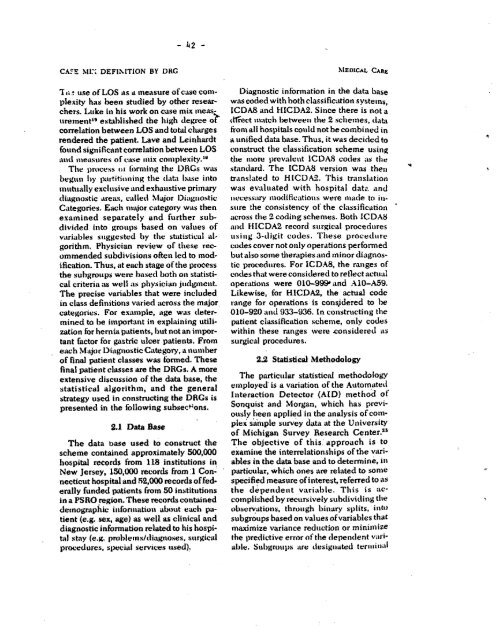BOOKS OF RtfiDIfGS - PAHO/WHO
BOOKS OF RtfiDIfGS - PAHO/WHO
BOOKS OF RtfiDIfGS - PAHO/WHO
Create successful ePaper yourself
Turn your PDF publications into a flip-book with our unique Google optimized e-Paper software.
CAME MIX DEFINITION BY DRG<br />
- 42 -<br />
'I~e use of LOS as a imeasure of case complexity<br />
has been studied by other researchers.<br />
Luke in his work on case mix measurement"l<br />
established the high degree ok<br />
correlation between LOS and total charges<br />
rendered the patient. Lave and Leinhardt<br />
found significant correlation between LOS<br />
and measures of case mnix complexity.'?<br />
The process sI lorming the DRCGs was<br />
beguin bIy partitioning the data )base into<br />
mutntally exclusive and exhaustive primary<br />
diagnostic areas, called Major Diaglnostic<br />
Categories. Each nmijor c;ategory was then<br />
examined separately and filrther subdivided<br />
into groups based on values of<br />
variables suggested by the statistical algorithmn.<br />
Physician review of these recommended<br />
subdivisions often led to modification.<br />
Thus, at each stage of the process<br />
the suhgroups were hased both on statistical<br />
criteria as well as physician judgment.<br />
The precise variables that were included<br />
in class definitions varied across the major<br />
categories. For example, age was determined<br />
to be important in explaining utilization<br />
for hernia patients, but not an important<br />
factor for gastric ulcer patients. From<br />
each Major Diagnostic Category, a number<br />
of final patient classes was formed. These<br />
final patient classes are the DRGs. A more<br />
extensive discussion of the data base, the<br />
statistical algorithm, and the general<br />
strategy used in constructing the DRGs is<br />
presented in the following subsect:ons.<br />
2.1 Data Base<br />
The data base used to construct the<br />
scheme contained approximately 500,000<br />
hospital records from 118 institutions in<br />
New Jersey, 150,000 records from 1 Connecticut<br />
hospital and 52,000 records of federally<br />
funded patients from 50 instittutions<br />
in a PSRO region. These records contained<br />
demnoglrphic inlfornation al>out each patient<br />
(e.g. sex, age) as well as clinical and<br />
diagnostic information related to his hospital<br />
stay (e.g. pro)lemns/(liagnoses, surgical<br />
procedures, special services used).<br />
MEDICAL CARE<br />
Diagnostic information in the data base<br />
was coded with both classification systems,<br />
ICDA8 and HICDA2. Since there is not a<br />
tlFect inatch between the 2 schelimes, data<br />
from all hospitals could not be combined in<br />
a unified data base. Thus, it was decided to<br />
construct the classification scheme using<br />
the miore prevalent ICDA8 codes as the<br />
standard. The ICDA8 version was then<br />
translated to HICDA2. This translation<br />
was evaluated with hospital dato. and<br />
itecessary modlitficatioiis were miade to insure<br />
the consistency of the classification<br />
across the 2 coding schemes. Both ICDA8<br />
and HICDA2 record surgical procedures<br />
tsiíng 3-digit codes. These procedure<br />
codes cover not only operations performed<br />
but also some therapies and minor diagnostic<br />
procediures. For ICDA8, the ranges of<br />
codes that were considered to reflect actual<br />
operations were 010-999 and A10-A59.<br />
Likewise, for HICDA2, the actual code<br />
range for operations is consjdered to he<br />
010-920 and 933-936. In constructing the<br />
patient classification scheine, only codes<br />
within these ranges were considered as<br />
surgical procedures.<br />
2.2 Statistical Methodology<br />
The particular statistical methodology<br />
employed is a variation of the Automated<br />
Interaction Detector (AID) method of<br />
Sonquist and Morgan, which has previously<br />
heen applied in the analysis of conmplex<br />
saniple survey data at the UniversitY<br />
of Michigan Survey Research Center.2?<br />
The objective of this approach is to<br />
examine the interrelationships of the variables<br />
in the data base and to determine, in<br />
particular, which ones are related to sonme<br />
specified measure of interest, referred to as<br />
the dependernt variable. This is accomplished<br />
by recursively subdividing the<br />
observations, through binary splits. inito<br />
subgroups based on values of variables that<br />
maximize variance reduction or minimize<br />
the predictive error of tlie depeindent vairiable.<br />
Subgroups aire designated termiiiiiinal<br />
'4

















